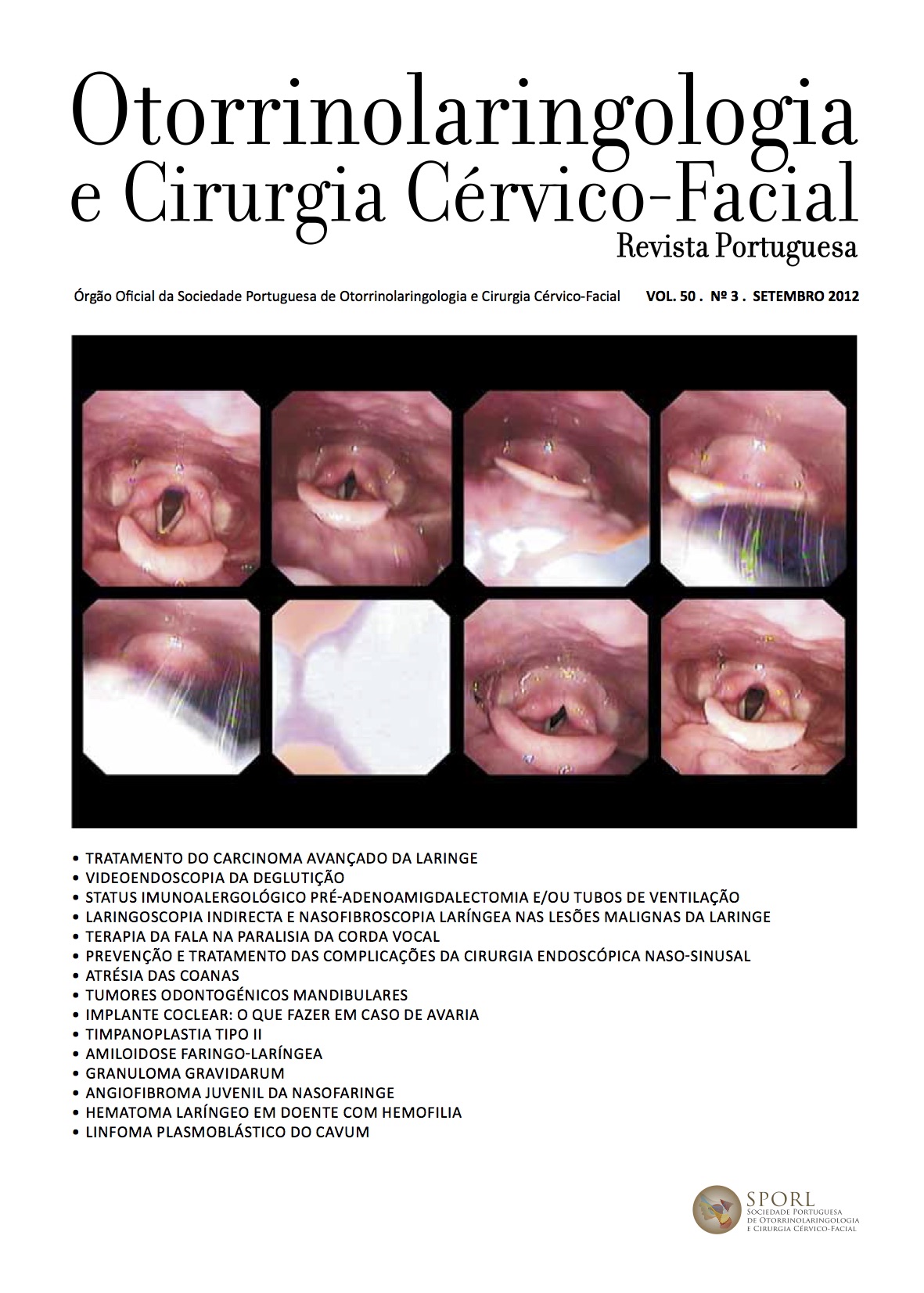The effectiveness of intervention by speech therapy in vocal fold paralysis: Objective assessment
DOI:
https://doi.org/10.34631/sporl.115Keywords:
vocal cord paralysis, voice disorders, Speech Therapy, assessment of voice, acoustic analysisAbstract
Objective: To analyze the results achieved by a group of patients with vocal fold paralysis using objective assessment measures before and after intervention of Speech Therapy.
Methods: Retrospective analysis of the results obtained by a group of 38 patients with vocal cord paralysis underwent intervention by Speech Therapy at a Central Hospital.
Results: The type of paralysis was variable and the majority of subjects had unilateral paralysis in paramedian position. Differences in performance parameters of jitter, shimmer and NNE were significant (p <0.05).The average number of sessions needed was 13.29 ± 7.95.
Conclusions: Speech Therapy intervention in cases of vocal fold paralysis started early is effective and avoided surgical procedures, since they have significant improvements in voice quality with therapeutic intervention.
Downloads
References
Sulica, L, Cultrara, A, Blitzer, A. Vocal Fold Paralysis: Causes, Outcomes and Clinical Aspects. In: Sulica L, Blitzer A. Vocal fold
paralysis. New York: Springer; 2006. p. 33-48.
Dalston R, Marquardt T. Laryngeal and Orofacial Disorders. In: Gillam R, Marquardt T., Martin F, editors. Communication sciences
and disorders - from science to clinical practice. USA: Jones and Barlett Publishers; 2011. p. 123-50.
Verdolini K, Rosen CA, Branski RC, Andrews ML, American Speech-Language-Hearing Association. Special Interest Division 3 V, Disorders V. Classification manual for voice disorders-I: Lawrence Erlbaum; 2005.
Simpson C, Cheung E. Evaluation of Vocal Fold Paralysis. In: Sulica L, Blitzer A. Vocal fold paralysis. New York: Springer; 2006. p. 55-61.
Simpson B, Rosen C. Operative Techniques in Laryngology. Leipzig: Springer; 2008.
Casper J. Vocal fold paralysis – paresis – immobility. In: Freeman F, Fawcus M, editors. Voice Disorders and Their Management. United Kingdom: Whurr Publishers; 2000. p. 172-91.
Hartl DM, Hans S, Vaissiere J, Riquet Met al. Objective voice quality analysis before and after onset of unilateral vocal fold paralysis. J Voice. 2001 Sep;15(3):351-61.
Pouchoulin G, editor. Approche Statistique pour L`Analyse Objective et la Caractérisation de la Voix Dysphonique [monograph on the internet]. Avignon: Université d`Avignon et des Pays de Vaucluse; 2008. Available from: http://www.univ-avignon.fr/.
Pinho S, Tsuji D, Bohadana S. Fundamentos em Laringologia e Voz. Rio de Janeiro: Guanabara Koogan; 2006.
Yu P, Ouaknine M, Revis J, Giovanni A. Objective voice analysis for dysphonic patients: a multiparametric protocol including acoustic and aerodynamic measurements. J Voice. 2001 Dec;15(4):529-42.
Oguz H, Demirci M, Safak MA, Arslan N, et al. Effects of unilateral vocal cord paralysis on objective voice measures obtained by Praat. Eur Arch Otorhinolaryngol. 2007 Mar;264(3):257-61.
Kandogan T, Seifert E. Influence of aging and sex on voice parameters in patients with unilateral vocal cord paralysis. Laryngoscope. 2005 Apr;115(4):655-60.
Little MA, Costello DA, Harries ML. Objective dysphonia quantification in vocal fold paralysis: comparing nonlinear with
classical measures. J Voice. 2011 Jan;25(1):21-31.
Fang TJ, Li HY, Gliklich RE, Chen YH, et al.. Quality of life measures and predictors for adults with unilateral vocal cord paralysis.
Laryngoscope. 2008 Oct;118(10):1837-41.
Vaz-Freitas S. A avaliação das alterações vocais: registo e análise áudio-perceptual e acústica da voz. In: Peixoto V, Rocha J.
Metodologias de Intervenção em Terapia da Fala. Porto: Edições Universidade Fernando Pessoa; 2009. p. 225-253.
Behlau M, editor. Voz - O Livro do Especialista - Volume II. São Paulo: Revinter; 2005.
Guimarães I. A Ciência e a Arte da Voz Humana. Alcoitão: Escola Superior de Saúde do Alcoitão; 2007.
Massachusetts Eye and Ear Enfermary (MEEE) Voice and Speech Lab. Disordered Voice Database, version 1,03. CD-ROM & Operations Manual. New Jersey: Kay Elemetrics Corps; 1994.
Moran RJ, Reilly RB, de Chazal P, Lacy PD. Telephony-based voice pathology assessment using automated speech analysis. IEEE Trans Biomed Eng. 2006 Mar;53(3):468-77.
Behlau M, editor. Voz - O Livro do Especialista - Volume I. São Paulo: Revinter; 2001.
Schindler A, Bottero A, Capaccio P, Ginocchio D, et al. F. Vocal improvement after voice therapy in unilateral vocal fold paralysis. J Voice. 2008 Jan;22(1):113-8.
Cantarella G, Viglione S, Forti S, Pignataro L. Voice therapy for laryngeal hemiplegia: the role of timing of initiation of therapy. J
Rehabil Med. 2010 May;42(5):442-6.






